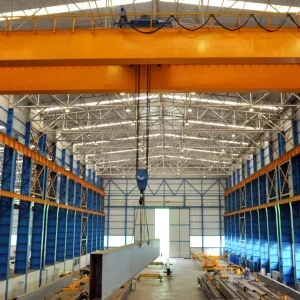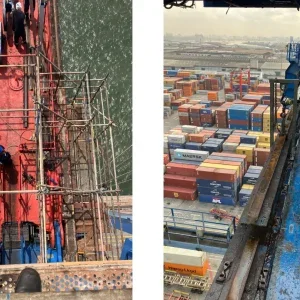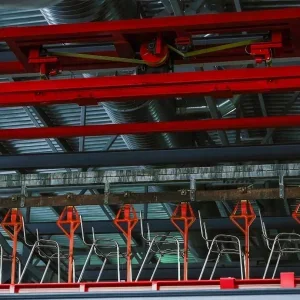Taiwan’s hoist producing industry has witnessed a number of important changes in its key domestic market since the late 1990s that will have a long term impact on the future development of the industry. Hoist manufacturers’ main concern is the relentless migration of traditional manufacturing industries from Taiwan to China and other lower cost production centres in Asia such as Vietnam. With few new factories being built in Taiwan and public projects the main creator of new business, Taiwan’s hoist manufacturers are being forced to develop export markets to ensure their long term security.
One company looking to expand its export business is Taiwan Hoist and Crane Co Ltd (THAC) of Taichung in central Taiwan. Its main products include electric wire hoists, electric chain hoists, end cages, and industrial and small scale winching systems, along with a wide range of crane and hoist parts. In addition the company supplies spun girders, bus girders and long edge beams. The largest equipment supplied includes a 200t gantry crane and a 100t EOT crane.
As well as its main factory in Taichung, THAC also has subsidiary operations in Shanghai and Guangzhou in China and in Vietnam.
Many of THAC’s overseas customers are Taiwanese companies that have set up factories in China and Southeast Asia. According to THAC general manager, George Wu, the first large wave of Taiwanese companies to move offshore occurred in the early 1990s when garment, textile, fashion bag and footwear manufacturers set up factories in Thailand and Indonesia. These customers typically require light cranes and hoists of two or three tons safe working load (SWL).
The second phase of offshore investment occurred in the mid-1990s when many other traditional factories started moving to Guangdong Province in China. Many were textile plants and factories making plastic toys that need hoists ranging from five to 10 tons.
“About 90% of our customers in Vietnam and China are Taiwanese factories,” Wu says.
“We offer components and accessories and drawing to make the steel structure locally,” Wu says, noting that steel bus beams over 12 metres in length are too long to be shipped by container. “We ask the branch office or agent to set up steel structure facilities to fabricate for customers. We have steel structure plants in China and Vietnam, but the components, end cage, motor and accessories are imported from Taiwan.” Some clients choose monorail beams or EOT cranes of six to seven metres. The biggest monorail beams supplied are 25 to 30 metres long. These usually are installed in machinery factories.
In China, THAC supplies gantry cranes up to maximum of 15t SWL. These are used in the stone cutting industry to move granite blocks about while EOT cranes are supplied for moving construction girders and steel bus beams.
Apart from supplying hoists to new factories being built in China, THAC’s main client groups are three to five year old factories that order additional hoists to assist their expanding operations.
China still is the main destination for Taiwanese companies deciding to set up a production base overseas. Recently Vietnam has grown in importance as an important investment centre in southeast Asia.
“Most Taiwanese factories invest in China and Vietnam,” Wu says. “Our main customers are factory owners so we set up a branch operation in Ho Chi Minh City in Vietnam in 2001 after earlier setting up an operation in Shanghai in 1996 and in Guangzhou [Guangdong Province] in China in 1998.” Meanwhile, the transfer of traditional manufacturing industries to China recently has expanded to include some of Taiwan’s newer industrial sectors. “During the past two or three years hi-tech companies have started moving to China,” Wu says, “especially personal computer and laptop computer companies moving to Suzhou and Kumsan area in Jiangsu Province near Shanghai. These companies need hoists of two to three tons.” The choice of factory location in China also has started to change recently. Wu explains: “Five years ago everyone was moving to Guangdong Province, but for the past two to three years it has been Shanghai. Materials suppliers have moved to Guangdong while large companies move to Shanghai. Some Taiwanese factories moved to Shanghai last year as their customers opened a factory in Shanghai and they must be near to their customers.” “Shanghai and Vietnam are competitive hoist markets. The markets are big but hoist prices are very competitive,” he says.
Taiwan Hoist and Crane’s sales from the Shanghai operation were US$3.5m in 2002 compared with $2.5m in 2001. This year the company expects sales in Shanghai to rise to about $4m. Profits, however, are likely to fall due to price competition.
Competitors in Shanghai include Kito of Japan and Finland’s KCI Konecranes which has a local joint venture there. Shanghai High Tech Industrial Crane Company is 25% owned by Konecranes, 63% owned by Shanghai Qingjie Colour-Coated Steel Sheet and 12% by Euro Mechanical & Electronic. It has a license agreement to produce Konecrane-designed hoists.
There is also plenty of other competition in Shanghai. At least eight Taiwanese hoist and crane manufacturers have a presence in Shanghai, according to Wu, and about 10 Chinese hoist and crane manufacturers have established factories in Shanghai and nearby Jiangsu and Zhejiang provinces.
“All these hoist and crane factories use about 80% of their production capacity,” Wu says. “Orders are OK, but prices are very bad.” Sales of the Guangzhou subsidiary in Guangdong, southern China, were $2m in 2002, remaining unchanged from the previous year. Wu notes that more factories were built in Shanghai last year than in Guangdong which explains while sales were flat. However, sales in Guangzhou are expected to show a slight improvement in 2003.
Meanwhile, Taiwan Hoist recorded sales worth $500,000 from its new operation in Vietnam in 2002. Wu says that sales are still growing as the plant was set up only two years ago.
“We expect sales in Vietnam to reach $1.5m this year. The market is quite good as some factories such as textiles, plastic toys and shoe plants are moving from China to Vietnam because the labour cost is lower,” Wu says. “Vietnamese factory workers earn $40 a month while in Shanghai factory workers earn $100 and in Guangdong $70 to $80. Some Thai, Malaysian and Singaporean factories also are setting up in Vietnam as Vietnam is closer to their home country than China. Another reason for this investment is because the United States has opened its domestic market to Vietnamese products.” In Vietnam THAC supplies gantry cranes up to 30t capacity. The largest models are for use on construction sites or in concrete casting plants and concrete batching plants. EOT cranes up to 25t SWL are supplied. The largest models are installed in machinery assembly plants.
“Radio controlled hoists are popular,” Wu says. “Taiwan is the biggest radio remote control supplier in the world.” Taiwan Hoist and Crane supplies hoists fitted with radio remote controls made by several local manufacturers. Telecrane is believed to be the largest remote control systems manufacturer in Taiwan, producing more than 50,000 sets a year, while Apollo produces more than 20,000 and Alpha produces more than 6,000.
THAC’s main factory in Taichung, central Taiwan, employs 120 workers. In 2002 the company’s total sales were $13m compared with $20m in the peak sales year of 1997 just before the Asian financial crisis struck.
Among products that the company has recently introduced are an AC winch for industrial use (for pulling rather than lifting) and a DC winch for boat, DIY, truck and jeep use.
“Exports of parts were 40%, or $5m, of our total $13m in 2002,” Wu says. “Our local business is slow. This year I think our sales in Taiwan will be 10% less as most factories are moving. Few new factories are being built in Taiwan, there are only publicly funded projects.” “Some public projects for our business are almost finished like the high speed Taipei to Kaohsiung train. Coming up are Tatan power station, Tatan LNG terminal, Kaohsiung subway and Taipei subway expansion,” he says.
With domestic business opportunities limited by the general exodus of traditional industries, Taiwan Hoist will continue to focus on exports to secure its long term security. After shipping most exports to China and Southeast Asia, the company is looking to develop business opportunities further afield.
It has had some success. According to Wu, the company has supplied wheel blocks to Morris Material Handling Ltd in the UK and hoists to Thailand where Lee’s Machinery is a customer. In Malaysia the company supplies Top-Meh Machinery while in the Middle East customers include Tiger Steel and Koda Steel.
“We must export in future. We are trying the US and Europe. We will look for agents in Europe. It’s the same problem for other local hoist companies,” Wu says. “Supplying hoists under our brand or the customer’s brand is OK. We offer good quality products. We will match local regulations if we export to the United States and Europe.”






